
Petroleum Center is a populated place and ghost town in Cornplanter Township, Venango County, Pennsylvania, United States. In the 19th century, the name was also spelled "Petroleum Centre". The town today is almost deserted.

Petroleum Center is a populated place and ghost town in Cornplanter Township, Venango County, Pennsylvania, United States. In the 19th century, the name was also spelled "Petroleum Centre". The town today is almost deserted.
Petroleum Center is located at 41°30′58″N79°40′57″W / 41.51611°N 79.68250°W (41.516, -79.682), at an elevation of 1,070 feet (330 m) above sea level, along the banks of Oil Creek. It is most easily found on local maps at the intersection of Petroleum Center Road and Russell Corners Road, within Oil Creek State Park, approximately five miles north-northeast of Oil City. Petroleum Center lies near the tracks of the Oil Creek and Titusville Railroad.

As the name implies, Petroleum Center was developed during the Pennsylvanian oil rush of the mid-19th century. The first well was drilled on the George Washington McClintock Farm in 1860. Soon, a small community grew about halfway between Oil City and Titusville. George Henry Bissell, James Bishop and others formed the Central Petroleum Company which owned the farm in the beginning of 1866, when daily production topped 1,000 barrels per day. By the summer of 1866, over 3,000 people called the Centre home with a bank, two churches, a theater, a half-dozen hotels/boarding houses, and stores serving all the needs of the growing community. Bissel & Co. Banking House stimulated economic growth with its direct ties to financial institutions in New York City. President Ulysses S. Grant visited the town in 1871. When a fire devastated the nearby town of Pithole, Pennsylvania, that town's newspaper, the Pithole Daily Record, was relocated to Petroleum Center. The town was founded in 1866 and was essentially abandoned after 1873.

Venango County is a county in the Commonwealth of Pennsylvania. As of the 2020 census, the population was 50,454. Its county seat is Franklin. The county was created in 1800 and later organized in 1805. The county is part of the Northwest Pennsylvania region of the state.
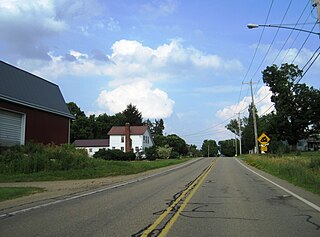
Oil Creek Township is a township in Crawford County, Pennsylvania, United States. The population was 1,703 at the 2020 census, a decrease from 1,877 at the 2010 census.

Titusville is a city in the far eastern corner of Crawford County, Pennsylvania, United States. The population was 5,262 at the 2020 census. Titusville is known as the birthplace of the American oil industry and for a number of years was the leading oil-producing region in the world. It was also notable for its lumber industry, including 17 sawmills, as well as its plastic and toolmaking industries. It is part of the Meadville micropolitan area.

Union City is a borough in Erie County, Pennsylvania, United States. It is located 22 miles (35 km) southeast of Erie. In the twentieth century, there were three large chair factories, planing and grist mills, a powdered milk plant, and several furniture factories. The population was 2,934 at the 2020 census. It is part of the Erie Metropolitan Statistical Area.

Oil City is the largest city in Venango County, Pennsylvania, United States. Known for its prominence in the initial exploration and development of the petroleum industry, it is located at a bend in the Allegheny River at the mouth of Oil Creek. The population was 9,608 at the 2020 census, and it is the principal city of the Oil City micropolitan area.
Wamsutta Oil Refinery was established around 1861 in McClintocksville in Venango County near Oil City, Pennsylvania, in the United States. It was the first business enterprise of Henry Huttleston Rogers (1840–1909), who became a famous businessman, industrialist and financier.
McClintockville, Pennsylvania was a small community in Cornplanter Township in Venango County located in the state of Pennsylvania in the United States.
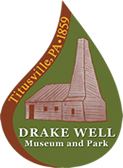
The Drake Well Museum and Park is a museum in Cherrytree Township, Pennsylvania that chronicles the birth of the American oil industry in 1859 by Colonel Edwin Drake. The museum collects and preserves related artifacts. The reconstructed Drake Well demonstrates the first practical use of salt drilling techniques for the extraction of petroleum through an oil well.

Pithole, or Pithole City, is a ghost town in Cornplanter Township, Venango County, Pennsylvania, United States, about 6 miles (9.7 km) from Oil Creek State Park and the Drake Well Museum, the site of the first commercial oil well in the United States. Pithole's sudden growth and equally rapid decline, as well as its status as a "proving ground" of sorts for the burgeoning petroleum industry, made it one of the most famous of oil boomtowns.

Oil Creek State Park is a Pennsylvania state park on 6,250 acres (2,529 ha) in Cherrytree, Cornplanter and Oil Creek Townships, Venango County, Pennsylvania in the United States. The park is adjacent to Drake Well Museum, the site of the first successful commercial oil well in the United States, that was drilled under the direction of Colonel Edwin Drake. Oil Creek State Park follows Oil Creek, between Titusville and Oil City, and is on Pennsylvania Route 8. While the creek is the park's main recreational attraction, it also contains the sites of the first oil boomtown and much of Pennsylvania's original oil industry. The park contains a museum, tableaux, and trails to help visitors understand the history of the oil industry there, and an excursion train.

Oil Creek is a 46.7-mile (75.2 km) tributary of the Allegheny River that is located in Venango and Crawford counties in the Commonwealth of Pennsylvania in the United States.
Charles Vernon Culver was a Republican member of the U.S. House of Representatives from Pennsylvania.
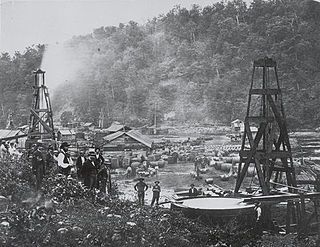
The oil rush in America started in Titusville, Pennsylvania, in the Oil Creek Valley when Edwin L. Drake struck "rock oil" there in 1859. Titusville and other towns on the shores of Oil Creek expanded rapidly as oil wells and refineries shot up across the region. Oil quickly became one of the most valuable commodities in the United States and railroads expanded into Western Pennsylvania to ship petroleum to the rest of the country.

The Oil Creek and Titusville Railroad is a tourist railroad that runs from Titusville to Rynd Farm north of Oil City in the U.S. state of Pennsylvania. The Oil Creek and Titusville Lines is the designated operator of the railroad, as well as the freight carrier on the line.
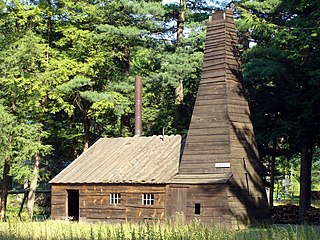
The Drake Well is a 69.5-foot-deep (21.2 m) oil well in Cherrytree Township, Pennsylvania, the success of which sparked the first oil boom in the United States. The well is the centerpiece of the Drake Well Museum located 3 miles (5 km) south of Titusville.
Oil Region National Heritage Area is a federally designated National Heritage Area in the northwestern portion of the U.S. state of Pennsylvania. The national heritage area commemorates and promotes the region surrounding Edwin Drake's oil well of 1859 near Titusville, which gave rise to the modern oil industry.
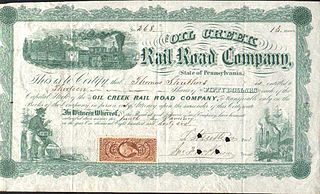
The Oil Creek Railroad Company (OCRR) was a railroad in western Pennsylvania.

Charles Miller was a Pennsylvania businessman, philanthropist and Major General of the Pennsylvania Army National Guard. He commanded the organization now known as the 28th Infantry Division and was a founder of the Galena-Signal Oil Company, which later became part of the Standard Oil combine, and then part of the corporations now known as Texaco and Valvoline.
The Pithole Valley Railway was an ephemeral short line railroad in Venango County, Pennsylvania, constructed as a result of the Pennsylvania oil rush. The railroad was originally constructed in 1865 between Oil City, Pennsylvania, a local oil transportation hub, and the boomtown of Pithole, Pennsylvania. Constructed under the charter of the Clarion Land and Improvement Company, it was informally known as the Oil City and Pithole Branch Railroad. Although it was generally supported by the broad gauge Atlantic and Great Western Railway, it was built to standard gauge. Conflict with the Warren and Franklin Railway over the right-of-way along the Allegheny River led to a lawsuit which, in 1866, declared that the Oil City and Pithole had no right to operate along the river from Oleopolis, Pennsylvania to Oil City. That part of the line was sold to the Warren and Franklin, leaving the Oil City and Pithole with a 7-mile (10 km) line running north from Oleopolis to Pithole along Pithole Creek.
The Pennsylvania Petroleum Railroad was a railroad in Pennsylvania originally chartered in 1871, during the Pennsylvania oil rush. Intended to provide an additional outlet from the Pennsylvania oil fields to Erie, Pennsylvania, it graded about ten miles of line in 1872, but was then caught up in the collapse of the Atlantic and Great Western Railroad, which halted the project. The company was foreclosed and reorganized under new names many times, but accomplished relatively little. It laid a short segment of line in 1890 in Titusville, Pennsylvania which was leased to a subsidiary of the New York Central to be used as a siding to a tannery. Further construction took place in 1913 with the idea of opening it as an electric railway to Cambridge Springs, but this, too, was never completed.
Giddens, Paul H. "The Birth of the Oil Industry" (New York: Macmillan co., 1938).